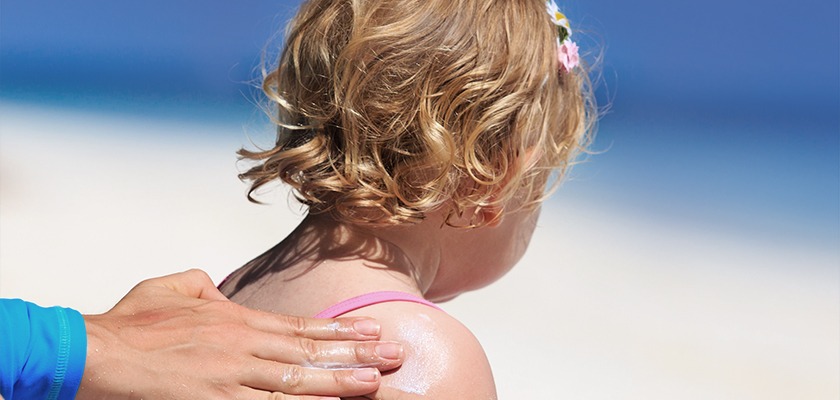How is Baby Skin Different?
Baby skin may be soft and smooth, but it’s also more sensitive than skin that is just a year or two older1. One reason is because babies have a thinner stratum corneum, which is the outmost layer of dead skin cells that helps protect the body from external irritants.2 (This is why a moisturizer with ceramides that helps maintain the skin’s barrier is important for babies.) When you combine all of these attributes of newborn skin, a sunburn causes more than redness and discomfort—and can lead to dehydration, a fever, blisters, infections and heatstroke.1
When Can Babies Wear Sunscreen?
Now that you understand why babies’ skin is so sensitive and delicate, you’re probably wondering, when can you put sunscreen on a baby? These are the general baby sunscreen3 age guidelines:
Babies younger than six months: Many dermatologists recommend avoiding sun exposure and the use of sunscreen in babies younger than six months old4. It’s best to keep them out of direct sunlight, in the shade and dressed in long-sleeves, pants, wide-brimmed hats and sunglasses. A lightweight, breathable, full-body onesie in a bright color is ideal, since white and pastel colors can allow more UV rays to reach the skin5.
Babies older than six months: After six months of age, broad spectrum, water resistant, physical- or chemical-based UV filters are recognized as safe and effective by the FDA, although it is recommended to continue keeping them in the shade and covered with clothing.6

What to look for in a baby sunscreen
There are no specific U.S. FDA guidelines for baby sunscreen7, which is why it’s best to have a conversation with your dermatologist or pediatrician about the ideal UV filters or formulation for your child.
As with all sun protection products, a baby sunscreen should have an SPF of at least 30, provide broad spectrum protection against UVA and UVB rays, and be water resistant for up to 40 or 80 minutes if the baby will be in or around water. Some baby sunscreen products are specially-formulated to provide the skin with additional benefits, and ingredients such as ceramides to help reinforce the skin barrier and calming niacinamide can be beneficial as well.
Baby sun protection pointers
When you start applying baby sunscreen after the age of six months, there are a few special considerations1 to keep in mind. First, always keep an eye on your baby after you apply sun protection (or any skincare product) because you want to prevent your infant from licking sunscreen off his or her fingers or any other skin he or she can get in his or her mouth. Although you should apply baby sunscreen to the entire face (and head), it’s important to be careful around the eyes and avoid the eyelids.1
You may also want to consider applying baby sunscreen per the directions on the label if spending a prolonged amount of time in the car8 during daylight hours. UVA rays are able to penetrate glass, which means your baby could be exposed without you realizing. Placing the car seat in the middle of the back seat can reduce exposure, and applying a UV-blocking film to all car windows can block nearly 100% of the sun’s damaging rays and help protect the entire family.1
- https://www.skincancer.org/prevention/sun-protection/children/infants
- Seidenari, S., Giusti, G., Bertoni, L., Magnoni, C., Pellacani, G. (2000). Thickness and echogenicity of the skin in children as assessed by 20-MHz ultrasound. Dermatology, 201(3), 218-222.
- https://www.mayoclinic.org/healthy-lifestyle/infant-and-toddler-health/expert-answers/baby-sunscreen/faq-20058159
- https://www.fda.gov/ForConsumers/ConsumerUpdates/ucm309136.htm
- Hurwitz, S. (2008). The sun and sunscreen protection: recommendations for children. Journal of Dermatology & Dermatologic Surgery, 14(6), 657-660.
- https://www.aad.org/public/spot-skin-cancer/learn-about-skin-cancer/prevent/say-yes-to-sun-protection
- https://www.aad.org/media/news-releases/sun-protection-for-kids
- https://www.skincancer.org/prevention/are-you-at-risk/sun-hazards-in-your-car
